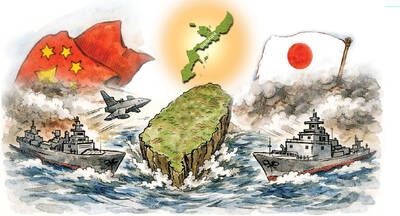Sesame oil chicken, beef, pig knuckle — not exactly the flavors to expect at an ice cream shop, let alone one that’s been in business since 1947.
Yet these are a few of the long-standing choices on the menu at Snow King (雪王), located near Zhongshan Hall (中山堂) in Ximending (西門町). The shop serves more than 70 flavors of fresh homemade ice cream (priced between NT$60 and NT$120 per scoop), which range from the classic to the bizarre.
At Snow King you get “the tastes that Taiwanese know,” says 28-year-old Kao Ching-feng (高慶豐), who recently took over as the third-generation owner of the shop. “Local flavors” and “old-fashioned style” keep customers and tourists coming for repeat visits, he says.
The regulars come for the house specialties, red bean and watermelon, while the tourists, mainly from Japan and Hong Kong, often go for the exotic flavors, according to Kao. He says the Japanese prefer lychee and peach; Hong Kongers like curry and wasabi.
The unusual flavors are a source of pride for Snow King. All of the shop’s recipes, now a family secret, were conceived by Kao’s grandfather, Kao Jih-hsing (高日星), who founded the business on savings from selling ice cream on the streets of Taipei.
“He liked to challenge himself,” says Kao Ching-feng of his grandfather, who would spend years tweaking a flavor to his satisfaction. One of the elder Kao’s more notable challenges: accommodating his older, diabetic customers. He came up with a selection of non-sugared, savory ice creams, which include tofu (NT$70) and rousong (dried meat flakes, 肉鬆), which remains a popular choice among customers, says Kao Ching-feng.
The elder Kao, 82, retired from running the shop 10 years ago and only visits occasionally, but his influence remains strong. Kao Ching-feng and his family continue to make all of Snow King’s ice cream with fresh, local produce. The wasabi is grown on Alishan (阿里山), the kaoliang liquor comes from Kinmen (金門), and savory flavors like the sesame oil chicken are cooked on the spot. Korean ginseng is the one exception to the shop’s exclusively Taiwanese ingredients.
In contrast to its daring menu, the store’s appearance is modest, with its open storefront marked only by a large freezer with the Chinese characters for “Snow King” (雪王) painted on the front. The shop looks slightly unkempt under the glare of fluorescent lighting, but it’s clean and quiet, save for the television at low volume in the back kitchen, the occasional clang of pots and pans, and the hum of a mixing machine.
The elder Kao also left his mark in the shop’s interior, which has changed little from 27 years ago, when they moved from their original location on Hankou Street (漢口街). Customers sit at sturdy, solid wood countertops and matching stools, which the elder Kao had made to order. The simple furniture takes customers back to the old days, says Kao Ching-feng.
One other thing hasn’t changed: making the ice cream remains a labor-intensive job. Kao Ching-feng says that particularly time-consuming flavors are Buddha’s head fruit, which has to be peeled bit by bit, and pig knuckle, which requires lengthy cooking times.
With the long hours and never-ending schedule — Snow King is open 365 days a year — Kao Ching-feng admits that running the shop gives him less freedom than his previous job in insurance, and cuts into his favorite past times, mountaineering and biking.
But he thinks about his grandfather. “[He] was very steadfast … he told me, ‘you must work hard to make more money,’” he said. “He gave me my values.”

Most heroes are remembered for the battles they fought. Taiwan’s Black Bat Squadron is remembered for flying into Chinese airspace 838 times between 1953 and 1967, and for the 148 men whose sacrifice bought the intelligence that kept Taiwan secure. Two-thirds of the squadron died carrying out missions most people wouldn’t learn about for another 40 years. The squadron lost 15 aircraft and 148 crew members over those 14 years, making it the deadliest unit in Taiwan’s military history by casualty rate. They flew at night, often at low altitudes, straight into some of the most heavily defended airspace in Asia.

Taiwan’s democracy is at risk. Be very alarmed. This is not a drill. The current constitutional crisis progressed slowly, then suddenly. Political tensions, partisan hostility and emotions are all running high right when cool heads and calm negotiation are most needed. Oxford defines brinkmanship as: “The art or practice of pursuing a dangerous policy to the limits of safety before stopping, especially in politics.” It says the term comes from a quote from a 1956 Cold War interview with then-American Secretary of State John Foster Dulles, when he said: ‘The ability to get to the verge without getting into the war is

Beijing’s ironic, abusive tantrums aimed at Japan since Japanese Prime Minister Sanae Takaichi publicly stated that a Taiwan contingency would be an existential crisis for Japan, have revealed for all the world to see that the People’s Republic of China (PRC) lusts after Okinawa. We all owe Takaichi a debt of thanks for getting the PRC to make that public. The PRC and its netizens, taking their cue from the Chinese Communist Party (CCP), are presenting Okinawa by mirroring the claims about Taiwan. Official PRC propaganda organs began to wax lyrical about Okinawa’s “unsettled status” beginning last month. A Global

Like much in the world today, theater has experienced major disruptions over the six years since COVID-19. The pandemic, the war in Ukraine and social media have created a new normal of geopolitical and information uncertainty, and the performing arts are not immune to these effects. “Ten years ago people wanted to come to the theater to engage with important issues, but now the Internet allows them to engage with those issues powerfully and immediately,” said Faith Tan, programming director of the Esplanade in Singapore, speaking last week in Japan. “One reaction to unpredictability has been a renewed emphasis on